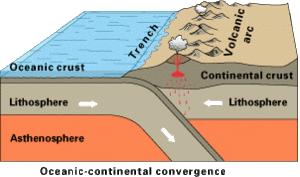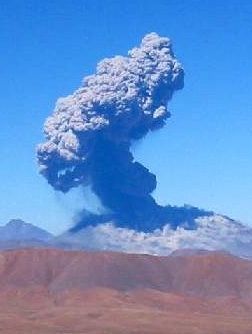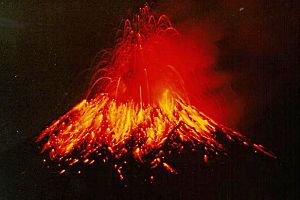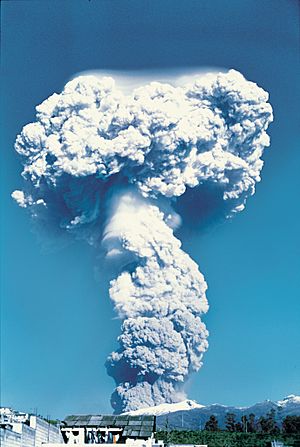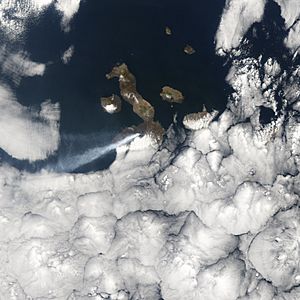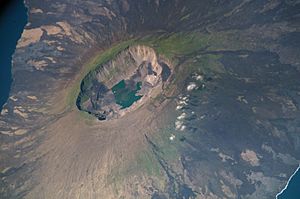Volcanoes of South America facts for kids
South America is home to many amazing volcanoes! Most of them are found along the Andes mountains. These volcanoes are part of a huge chain called the Pacific Ring of Fire. This "Ring" is where many earthquakes and volcanoes happen all around the Pacific Ocean.
The Andes mountains and their volcanoes were created over millions of years. This happened because the land of the Americas has been slowly moving west. This slow movement is called continental drift. As the land moves, the oceanic plate (a huge piece of the Earth's crust under the ocean) slides underneath the continental plate (the land where we live). This process is called subduction. When plates slide past each other, it builds up mountains and causes volcanoes to erupt.
But not all volcanoes form this way! The Galápagos Islands are different. They were made by a "hotspot" deep under the Earth's surface. This hotspot sends hot rock up, causing the islands and their volcanoes to rise from the ocean floor.
Contents
Volcanoes of the Andes
The Andes mountains stretch along the western side of South America. They are a major home for many volcanoes.
Bolivia's Volcanoes
Bolivia has many volcanoes, some active and some not. The active ones are in western Bolivia, forming the edge of a high plateau called the Altiplano. Many of these active volcanoes are shared with neighboring Chile. Bolivia also has old volcano remains in its eastern part, from a very ancient time called the Precambrian era.
Chile's Volcanoes
Chile experiences many earthquakes because the Nazca Plate is sliding under it. Chile even holds the record for the biggest earthquake ever recorded, the 1960 Valdivia earthquake.
Villarrica is one of Chile's most active volcanoes. It stands tall above Villarrica Lake and the town of Villarrica. This volcano is a stratovolcano, which means it's cone-shaped and built up by many layers of hardened lava and ash. A huge bowl-shaped area called a caldera formed here over 900,000 years ago.
Llaima Volcano is another very large and active volcano in Chile. It's located inside Conguillío National Park. People have been writing about Llaima's eruptions since the 1600s. It usually has moderate explosive eruptions, sometimes with lava flows. Its last big eruption was in 1994.
Chile has seen many eruptions from its 60 volcanoes, including Llaima and Chaitén Volcano.
Lascar Volcano is the most active volcano in the northern Chilean Andes. Its biggest eruption happened about 26,500 years ago. Since the mid-1800s, Lascar has had many small to medium-sized explosive eruptions.
Villarrica is special because it's one of only five volcanoes in the world with an active lava lake inside its crater. It often has strombolian eruptions, which means it throws out fiery rocks and lava flows. When snow and ice melt from the volcano, or when it rains heavily, it can cause huge mudslides called lahars. This happened during its eruptions in 1964 and 1971.
Ecuador's Volcanoes
Cotopaxi is a tall stratovolcano in the Andes Mountains of Ecuador. It's about 50 kilometers (31 miles) south of Quito, the capital city. It's the second highest peak in Ecuador. Some people think it's the world's highest active volcano. Others give that title to Llullaillaco, which last erupted in 1877. Since 1738, Cotopaxi has erupted more than 50 times. These eruptions have created many valleys around the volcano due to mudflows (lahars).
In October 1999, Pichincha Volcano erupted in Quito. It covered the city with several inches of ash. Before that, its last major eruptions were in 1553 and 1660. In 1660, about 30 centimeters (12 inches) of ash fell on the city.
Sangay Volcano is an active stratovolcano in central Ecuador. It's one of the highest active volcanoes in the world. It's also one of Ecuador's most active, erupting three times in recorded history. It mostly shows Strombolian activity, like Villarrica. Its most recent eruption started in 1934 and is still going on! Sangay is located where two large pieces of the Earth's crust meet, which explains why it's so active. Sangay's history, going back about 500,000 years, has been unstable. Two older versions of the mountain were destroyed by huge collapses. Sangay is one of two active volcanoes in Sangay National Park. The park is a UNESCO World Heritage Site.
Reventador is another active stratovolcano in the eastern Andes of Ecuador. Since 1541, it has erupted over 25 times. Its most recent eruption was in 2009. The biggest eruption happened in 2002. During that eruption, the ash plume reached a height of 17 kilometers (10.5 miles). Hot, fast-moving flows of gas and rock, called pyroclastic flows, traveled up to 7 kilometers (4.3 miles) from the volcano. On March 30, 2007, the mountain spewed ash again, reaching about 3 kilometers (1.8 miles) high. No one was hurt, and no damage was reported.
Galápagos Islands Volcanoes
The Galápagos Islands are a group of volcanoes located about 1200 kilometers (745 miles) west of Ecuador. They are shield volcanoes, which means they have a broad, gently sloping shape like a warrior's shield. They were formed by the Galápagos hotspot. The islands are between 4.2 million and 700,000 years old.
The largest island, Isabela Island, is made up of six shield volcanoes that have grown together. Each one has a large caldera at its top. Española, the oldest island, and Fernandina, the youngest, are also shield volcanoes. Most of the other islands in the chain are also shield volcanoes. The Galápagos Islands sit on a large lava platform. This platform makes the water around the islands shallow, between 360 to 900 meters (1,180 to 2,950 feet) deep. The islands stretch over 174 kilometers (108 miles) across.
Since Charles Darwin visited the islands in 1835, there have been over 60 recorded eruptions from six different shield volcanoes. Out of 21 volcanoes that rise above the sea, 13 are considered active.
Blue Hill is a shield volcano on Isabela Island. It's one of the most active volcanoes in the Galapagos. Its last eruption was between May and June 2008. The Galápagos islands are geologically young for such a big chain. The way their rift zones (cracks where the Earth's crust pulls apart) are arranged follows two main directions. The lava from the Galápagos shield volcanoes is very similar to the lava from the Hawaiian volcanoes.
How these islands formed is still a bit of a mystery, but there are several ideas. Sierra Negra (Black Mountain) is a large shield volcano on Isabela Island. It rises to 1124 meters (3,688 feet) high. It connects with Cerro Azul to the west and Alcedo to the north. Sierra Negra is one of the most active volcanoes in the Galapagos. Its last eruption started on October 22, 2005, and lasted until October 30, 2005.
Alcedo Volcano is one of the six shield volcanoes that make up Isabela Island. Because it's in a remote location, its most recent eruption in 1993 wasn't even recorded until two years later!
Fernandina Island is the third largest and youngest island of the Galápagos. Like the others, it was formed by the Galápagos hotspot. This island is an active shield volcano that has been erupting since April 11, 2009.
Peru's Volcanoes
Volcanoes in Peru are watched closely by the Peruvian Geophysical Institute.
Sabancaya is an active stratovolcano in the Andes of southern Peru. It's about 100 kilometers (62 miles) northwest of Arequipa. It is the most active volcano in Peru. It has been erupting continuously since August 2014.
Ubinas is another active stratovolcano in southern Peru. It has also been erupting recently. Before 2006, this volcano had not erupted for about 40 years. On April 23, 2006, Peru declared a state of emergency in towns near the volcano. This means the government took special actions to help people. On April 28, 2014, Ubinas Volcano erupted an ash plume, even though there had been fewer earthquakes recently.


